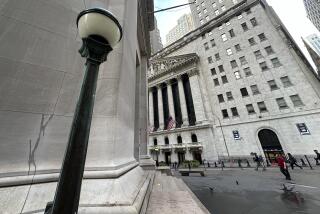Scandals Help Push Market to Its Worst First Half Since 1970
The first two quarters of 2002 were a season for scandal on Wall Street as allegations of accounting fraud and corporate misdeeds soured investors on stocks and helped drive the market to its worst first-half finish since 1970.
It was typical for the year that the second quarter ended Friday with news of yet another accounting snafu--this time at Xerox, which tumbled 13% after saying it inflated sales during the last five years.
Beginning with the Enron’s descent into bankruptcy proceedings late last year, investors have been bombarded by a series of corporate meltdowns, many of them involving accounting problems. The pace accelerated dramatically in recent weeks, with controversy engulfing current or former executives of Tyco International, ImClone Systems, Rite Aid and WorldCom in rapid succession.
Combined with mixed signals on the U.S. economy, a plunging dollar, continued unrest in the Middle East and warnings of more terrorist attacks at home, the scandals helped push the Standard & Poor’s 500 index to a 13.7% loss for the second quarter and a 13.8% loss for the first half of the year--the worst since the benchmark index lost 21% in the first half of 1970.
Bonds, meanwhile, are once again outperforming stocks: A Lipper Inc. index of long-term government bond mutual funds rose 3.7% in the first half. If the trend plays out through the end of the year, it would be the first time bonds have outperformed stocks three years in a row since 1939-41.
In recent days, the S&P; 500 and the technology-laden Nasdaq composite index dipped below the lows they hit in the big sell-off that followed September’s terrorist attacks. They remain dangerously close to those levels, although some analysts took heart that the market is showing some resilience despite the steady drumbeat of bad news.
“If the WorldCom torpedo couldn’t sink the battleship, then Xerox isn’t going to do it,” said Jon Brorson, director of equities for Northern Trust Co. “People are impressed that the Sept. 21 lows held in the face of disastrous news.”
The major indexes spent much of Friday in the black before giving up gains late in the day as President Bush announced he would undergo a colonoscopy today.
The Dow ended the day down 26.66 points, or 0.3%, at 9,243.26. The late slump left the Dow with a loss of 0.1% for the week--its sixth straight weekly decline. For the year, the index is off 7.8%.
The Nasdaq rose 4.01 points, or 0.3%, to 1,463.21 on Friday, and the S&P; 500 slipped less than a point to 989.82. Both indexes managed modest gains for the week, breaking five-week losing streaks.
Almost two stocks rose for every one that fell on the New York Stock Exchange, while three advanced for every two that declined on Nasdaq. Trading was very heavy as the NYSE had its fifth-busiest trading day ever and its most active session since Sept. 21.
Stocks were bolstered by a stronger-than-expected report on June consumer confidence. Although a Commerce Department report showed that U.S. consumer spending dropped 0.1% in May, reports earlier this week showed that the economy grew more than forecast in the first quarter. Leading economic indicators and home sales also gained more than expected.
“The underlying economic story is OK,” said Elizabeth Miller, money manager at Trevor Stewart Burton & Jacobsen Inc. “The market should certainly follow. If you really look long term, the stock market and the economy will move in step together.”
Others were less impressed, noting that investors remain wary of committing to the market given accounting woes and an uncertain outlook for earnings.
In other trading Friday, Treasury yields slipped and gold plummeted $5.70 to $313.50 an ounce--capping its biggest weekly loss in a year--as stabilizing stock prices drew money away from precious metals.
Among Friday’s highlights:
* General Motors shares rose $1.95 to $53.45, recouping the $1.58 it lost Thursday amid rumors--denied by GM--of irregular accounting. But Electronic Data Systems fell 15 cents to $37.15, adding to losses from Thursday amid worries about its exposure to WorldCom, which is a customer.
* Retail stocks were mixed after the consumer news. Wal-Mart Stores fell $2.69 to $55.01. But Claire’s Stores rose $1.24 to $22.90, having raised its second-quarter earnings forecast Thursday.
* Eli Lilly fell $3.43 to $56.40 after Lehman Bros. cut its rating on the stock to “buy” from “strong buy.” Other drug shares also declined. Pfizer lost $1.75 to $35, Johnson & Johnson dropped $2.15 to $52.26, Abbott Laboratories fell $1.50 to $37.65, and Wyeth shed $1.48 to $51.20.
* All 13 stocks in the Philadelphia paper products index rose. International Paper climbed $1.26 to $43.58, Temple-Inland advanced $1.27 to $57.86, and Weyerhaeuser gained 89 cents to $63.85.
* Media stocks recouped losses caused by accounting concerns. Viacom, owner of CBS and MTV, rose $2.79 to $44.46; AOL Time Warner gained $1.08 to $14.71.
* Overseas, Japan’s Nikkei stock index finished 3.5% higher. In Europe, France’s CAC-40 surged 4.2%, Britain’s FTSE 100 rose 2.6%, and Germany’s DAX climbed 2.9%.
Market Roundup, C4-5
More to Read
Inside the business of entertainment
The Wide Shot brings you news, analysis and insights on everything from streaming wars to production — and what it all means for the future.
You may occasionally receive promotional content from the Los Angeles Times.










